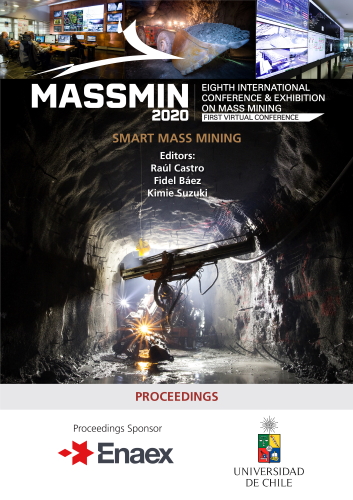Undercutting method selection at Cadia East PC2-3 extension

|
Authors: Orrego, C; Lowther, R; Newcombe, G |
This paper is hosted with the kind permission of Lulea University of Technology, International Conference & Exhibition on Mass Mining, 2024.
DOI https://doi.org/10.36487/ACG_repo/2063_23
Cite As:
Orrego, C, Lowther, R & Newcombe, G 2020, 'Undercutting method selection at Cadia East PC2-3 extension', in R Castro, F Báez & K Suzuki (eds), MassMin 2020: Proceedings of the Eighth International Conference & Exhibition on Mass Mining, University of Chile, Santiago, pp. 370-384, https://doi.org/10.36487/ACG_repo/2063_23
Abstract:
The PC2-3 extension is set to be the first expansion of a previously established panel cave at Cadia East, which presents a unique boundary condition for the cave establishment and initiation. The choice of the undercutting method and the subsequent assessment of personnel exposure relating to seismic hazard was investigated through a comparative numerical modelling assessment of both the advanced and post undercut methods for the Cadia East PC2-3 extension using FLAC3D. This paper details the numerical modelling approach and interpretation of the results between the two methods spanning initial development, and undercutting. The results show a comparison of the stress abutment formation within the operating levels during cave establishment for each method coupled with a quantitative personnel exposure analysis to determine which method had the least amount of exposure of personnel working within the stress abutments. The results demonstrated that while each method had varying levels of exposure within specific areas, the overall personnel exposure is less for the post undercutting method. This finding, complemented with positive business outcomes and the implementation of safety controls including dynamic ground support, pre-conditioning, and caving rules, inclined the decision towards this method.
References:
Cuello, D & Newcombe, G 2018, ‘Key geotechnical knowledge and practical mine planning guidelines in deep, high-stress, hard rock conditions for block and panel cave mining’, in Y Potvin & J Jakubec (eds), Proceedings of the Fourth International Symposium on Block and Sublevel Caving, Australian Centre for Geomechanics, Perth, pp. 17-36.
Flores-Gonzalez, G 2019, ‘Major hazards associated with cave mining: are they manageable?’, in J Wesseloo (ed.), Proceedings of the First International Conference on Mining Geomechanical Risk, Australian Centre for Geomechanics, Perth, pp. 31-46.
Glen, D 2019, ‘A review of hydraulic fracturing the Southern Seismic Zone’, Internal Technical Memorandum, 12 June 2019
Hoek, E., & Diederichs, MS 2006, ‘Empirical Estimation of Rock Mass Modulus’, Int. J. Rock Mech. Min. Sci., vol.43, pp. 203-215.
Itasca Australia Pty Ltd 2017a, ‘Numerical Assessment of Life of Mine Subsidence’, Report Ref: 17005_4.
Itasca Consulting Group Inc. 2017b, ‘FLAC3D — Fast Lagrangian Analysis of Continua in Three-Dimensions’, Ver. 6.0. Minneapolis: Itasca.
Kaiser, P. 2019, ‘From common to best practices in underground rock engineering’, 8th Mueller lecture presented at the 14th ISRM Congress, Brazil, CRC Press, pp. 141-182 in e-book.
Lee, M 2012, Cadia East – ‘Review of Rock Stress Measurements’, AMC Consultants Pty Ltd report to Newcrest Mining Limited. AMC 111153: February 2012.
Lett, J, Brunton, I, Capes, G, Jäger, A, Mobilio, B, Rachocki, J, Sharrock, G & Secheny, M 2016, ‘Undercutting to surface breakthrough – Cadia East panel cave (stage 1)’, in C Carr & G Chitombo (eds), Proceedings of the Seventh International Conference and Exhibition on Mass Mining, The Australasian Institute of Mining and Metallurgy, Melbourne, pp. 65–81.
Lorig, L & Pierce, M 2000, ‘Methodology and Guidelines for Numerical Modelling of Undercut and Extraction Level Behaviour in Caving Mines’, Report to International Caving Study. Minneapolis: Itasca Consulting Group. pp. 6.1-6.40.
Noma Consulting 2018, ‘Cadia East Panel Cave Life of Mine Caving Assessment’, Report: CAD4-NEW-NOM-GEO-RPT-0001-A.
Orrego, C 2018, Internal Technical Memorandum – ‘PC 2-3 Crusher Chamber Location Assessment’. [05 October 2018].
Pardo, C & Rojas, E 2016, ‘Selection of exploitation method based on the experience of hydraulic fracture techniques at El Teniente Mine’, in C Carr & G Chitombo (eds), Proceedings of MassMin 2016, The Australasian Institute of Mining and Metallurgy, Melbourne.
Rojas, E & Balboa, S 2017, ‘Management of seismic hazard in high stress condition, El Teniente mine’, in JA Vallejos (ed.), Proceedings of the 9th International Symposium on Rockbursts and Seismicity in Mines, University of Chile, Santiago, pp. 264–273.
© Copyright 2025, Australian Centre for Geomechanics (ACG), The University of Western Australia. All rights reserved.
View copyright/legal information
Please direct any queries or error reports to repository-acg@uwa.edu.au
View copyright/legal information
Please direct any queries or error reports to repository-acg@uwa.edu.au
